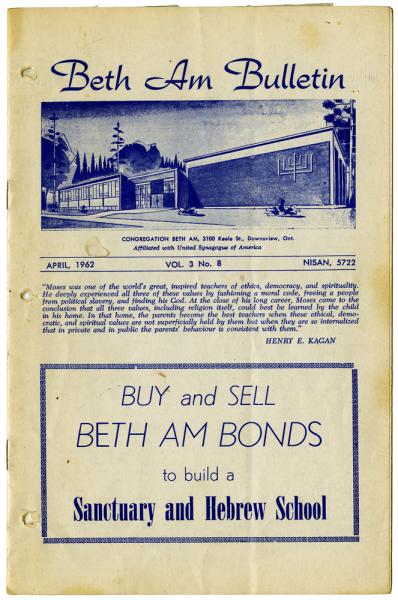“If you build it, he will come.”

You may recognize that line from the 1989 hit movie Field of Dreams. The central character, played by Kevin Costner, hears a voice instructing him to build a baseball field in the middle of an Iowa cornfield. If he did, the disgraced ballplayer Shoeless Joe Jackson, would magically appear. And he did.
In the 1950s, a similar impulse drove some pioneers of Toronto’s Jewish community. They believed if they built a synagogue in the middle of a Downsview farmer’s field, a Jewish community would magically appear. And it did, at least for awhile.
By the mid-1950s, Toronto’s Jewish community numbered about 75,000 people. It had already begun its northern migration, out of the downtown core, up to Forest Hill and Cedervale, all the way into North York.
But the religious centre of the community remained downtown. There were 48 synagogues in the city in 1954, but only five were located north of St. Clair Avenue. There were none west of Dufferin Street.
That wasn’t good enough for the 200 Jewish families who lived in the Downsview area. They were determined to build a synagogue of their own closer to home. In October 1954, the first meeting of the West Wilson Jewish Community Centre was held at Downsview Public School.
Over the next few months, organizers sought community input. Most residents wanted their synagogue to belong to the Conservative movement. And for the name, they chose Beth Am, which means “house of the people”.


The first step was to find a home for the house of the people. They discovered an estate for sale on Keele Street, just south of Sheppard Avenue and bought it for $35,000. This would be their field of dreams. A 130-year-old farm house was on the property. It needed a lot of work, but members of the congregation pitched in. They built a small chapel, hung a wrought-iron Star of David over the front door, and within a few months, the city’s only farm house synagogue was open for business. Four hundred people attended the first High Holiday services.
Bur religious services were just a small part of life at Beth Am. True to its name, it quickly became a vital hub for the small Downsview Jewish community. The Beth Am Hebrew School opened in September 1955 with forty students. There were also Girl Guide, Brownies, Cubs and Scout troops meeting there, and it was a venue for films and dances.
And then there was the Beth Am Players. No other synagogue in the city embraced musical theatre with as much gusto and creativity as the men and women of Beth Am. Few amateur community theatre groups in Toronto could match their output.
The Beth Am Players began life in 1957 as a way of raising money to help build a new synagogue. That mission was accomplished in 1963, but the Players kept on playing.


Some of their eagerly anticipated annual productions were adaptations of popular Broadway hits like Fiddler on the Roof (1965) and The Pajama Game (1967). Others were original productions with intriguing titles like My Fair Sadie (1967), Hello Molly (1969) and Poor Old World, We Love You Anyway (1971), a musical about a family who took a group of kids to Israel to live on a kibbutz.
The creative spark behind many of Beth Am’s original productions was Rosalyne Federman, whose pharmacist husband Al edited the synagogue’s newsletter. In a 2007 interview with the Toronto Star, Ros Federman admitted that she sometimes got pushback for spending so much time working with the Players.


“I have four kids and my mother said ‘why are you doing this? You should be home polishing the furniture’”, she told the Star.

But Ros Federman preferred the stage to domestic chores, although she did have an unusual way of dealing with writer’s block. “My creative juices were really flowing,” she told the Star, “but if I was blocked, I’d just go up and start baking a cake, and I’d have a notebook beside me and everything started flowing again.”
But even as the Beth Am Players thrived, attracting big crowds from all over the city, performing in hospitals and nursing homes, the synagogue itself was struggling. Keele St. proved to be too far west for most young Jewish families to settle. They preferred to stay closer to the Bathurst Street corridor.

In 1977, the last 128 Beth Am families decided to close the synagogue and merge with the Beth David B’nai Israel congregation near Bathurst and Sheppard.
But Beth Am’s musical theatre tradition remained. Their synagogue was gone, but the Beth Am Players continued to stage productions at their new home until 1992.
More Stories

Learning & Teaching in Downsview's Black Community
Knowledge is power is the motto of Downsview Secondary School. And, it’s the sharing of knowledge that empowers many of the Black community initiatives in the neighbourhood.

Italians in Downsview
If the kitchen is the heart of the home, then Downsview's Italian families are doubly blessed. Almost every home has two kitchens!
